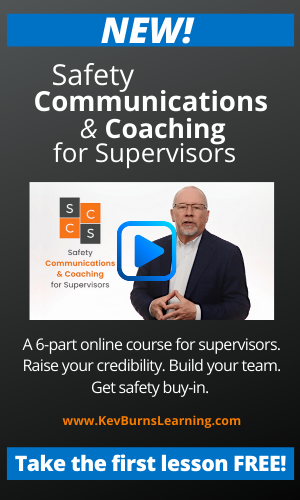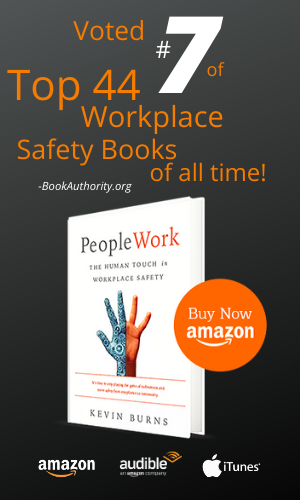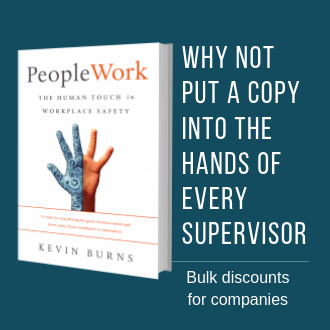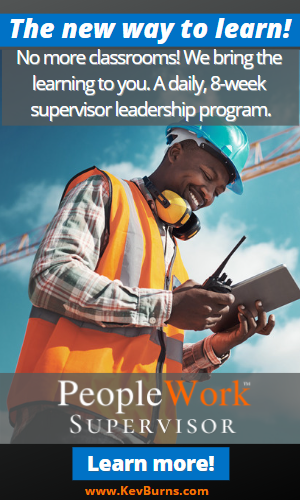Processes Don't Deliver Safety, People Do!
If you have been trying to help your team buy-in to safety but are having trouble getting the result you’d like, you may be focused on the wrong thing. In this week’s post, a three-step plan to improve the level of buy-in to the safety program.

It’s a fairly simple argument but when employees buy-in to the safety program, you don’t need to police them anymore. When your team buys-in to the safety program, they don’t forget their PPE at home or in the truck. They engage more in safety meetings. They show courtesy and respect to their fellow employees. In other words, policing, compliance enforcement and “gotcha” management goes right out the window. No smart thinking employee wants to work for a supervisor that engages in that demeaning stuff. Those outdated practices are used by supervisors who just don’t know any better. But you know better, don’t you?
But how do you get people to buy-in to safety? Here is a 3-step plan that will help improve your results in getting buy-in to the safety program:
Step 1 - Gain Trust
First, (as is presented in Lesson 4 in my course, Safety Communications & Coaching for Supervisors), your people buy-in to the leader before they buy-in to the safety program. That’s because processes don't deliver safety. People do. If it were processes, you wouldn’t need supervisors. But it’s people who make right or wrong decisions. It is people who impact a worker’s decision to stay with the company or leave.
Your people buy-in to the leader before they buy-in to the safety program.
A good supervisor in a tough culture can still hang on to her people. A poor supervisor can still cause people to leave a good company. A company is only as good as its people. A safety program is only as good as the people who engage safety. For supervisors, you have a decision to make about how you will be perceived. You can be feared, or you can be trusted. But you can not be both. People don’t trust the people they fear. People don’t fear the people they trust. Make a decision which way you want your people to look at you.
So, the first step is to gain their trust and be a decent human being.
Step 2 - Communicate Caring

Second, is the way you communicate with your team. A lot of new supervisors get nervous standing in front of their own people having to run the meetings. Because supervisors are nervous and don’t want to mess up, they put every thought in their heads in a PowerPoint slide. And, it ends up coming off like a lecture. So, here’s the thing you as a supervisor need to remember. Don't get wrapped up in preparing to “present” something to your people. Instead, try to make them feel something.
As discussed in the Safety Communications & Coaching for Supervisors course, you don’t have to spend your time trying to look like a supervisor. You’re not playing the part of a supervisor in a community theatre production. Don’t just talk because that’s what you think supervisors are supposed to do. It’s not. Supervisors are supposed to inspire and motivate, to engage and coach, to congratulate and support.
Supervisors are supposed to inspire and motivate, to engage and coach, to congratulate and support.
And lean on those gruesome photos and stories. Safety isn’t supposed to make you feel scared or make you feel sick to your stomach. Safety shouldn't make you sad. Safety should make you feel prepared and confident.
Your people will care about their safety when they know how much you care about them. Once people feel you care, they buy-in. The second step is to show that you care about your people’s safety. Really show it.
Step 3 - Do More Convincing

And finally, and this one is terribly important, spend more time convincing and less time controlling. You can’t control people’s choices, the outcomes and the results. But you can influence the thought process before the choices are made. Once your team is convinced to buy-in to safety, they don’t need to be controlled. If you invest your time in convincing them of safety’s importance, you get to spend a lot less time trying to control them. And trust me, the work is way more rewarding for both you and them. Be a provider of solutions instead of the creator of animosity and hard feelings.
If you feel that you have to enforce the rules, you're already behind. You’re starting from a deficit position. You're playing catch-up. You're not in front of the problem. You're behind it reacting. You don’t have the backing of your team. And you are creating another problem by embarrassing your employees.
Once employees buy-in and give their commitment to safety, it is difficult for them to go back to their old ways.
Do the selling work. Make the investment in convincing your team to join you in high-level productivity and high-level safety teamwork. Do the work with each employee and help them to see the benefits of doing their work safely. So, the third and final part; spend less time controlling and more time convincing.Once employees buy-in and give their commitment to safety, it is difficult for them to go back to their old ways. People buy-in to the person first, before they buy-in to what he or she is selling. You sell the safety program best one-by-one; not in a safety meeting through PowerPoint slides.
When employees buy-in to the safety program, there is less focus on catching them doing something wrong. The emphasis is on expecting that they will make the right decisions. You don’t expect them to act like amateurs anymore. You expect them to be professionals. You don’t set a low bar hoping they all can hit it. You raise the bar and expect them to step up and encourage each other to hit it. And then, once they’ve all achieved that level, you move the bar again – this time even higher. Don’t worry, if they’re connected as a team, they’ll step up to hit the new standard. That’s what pros do.
--
 Take the FREE preview lesson of Kevin's course Safety Communications & Coaching for Supervisors. 40-minutes of video instruction, summary download PDFs and a companion audio MP3 version to take with you on the go. SCCS is an online course to help energize safety, build teamwork, and get employee buy-in.
Take the FREE preview lesson of Kevin's course Safety Communications & Coaching for Supervisors. 40-minutes of video instruction, summary download PDFs and a companion audio MP3 version to take with you on the go. SCCS is an online course to help energize safety, build teamwork, and get employee buy-in.
Kevin Burns, consultant/author, works with smart, caring companies to energize safety culture, build teamwork, and get employee buy-in. KevBurns Learning is committed to to helping companies improve safety by improving people, through creative learning materials, virtual strategy sessions, safety meeting presentations, and team coaching programs.
In 2020, BookAuthority.org named PeopleWork #7 of The Top 44 Workplace Safety Books of All Time. Buy yourself a copy of PeopleWork: The Human Touch in Workplace Safety and give another as a gift to a colleague.
Subscribe to Kevin’s Blog.


